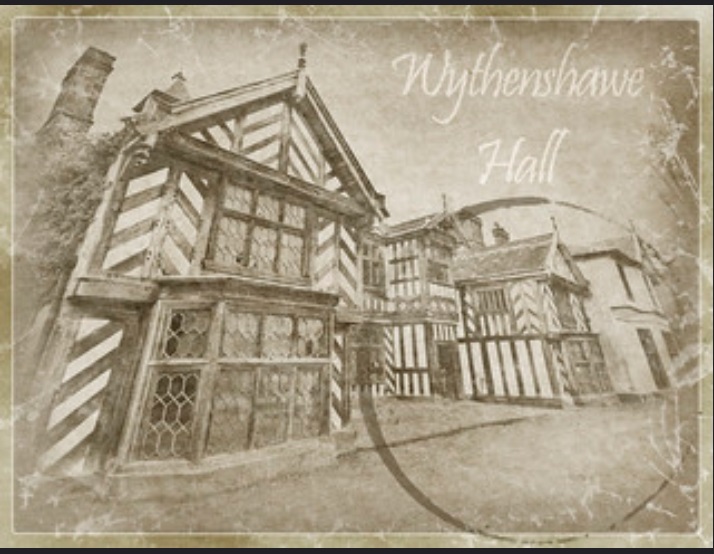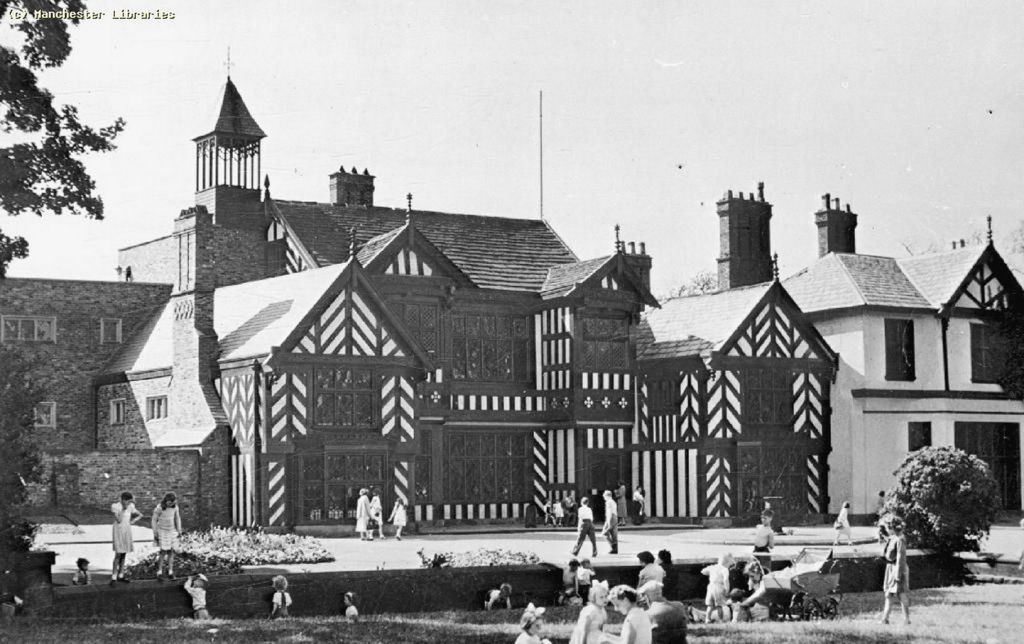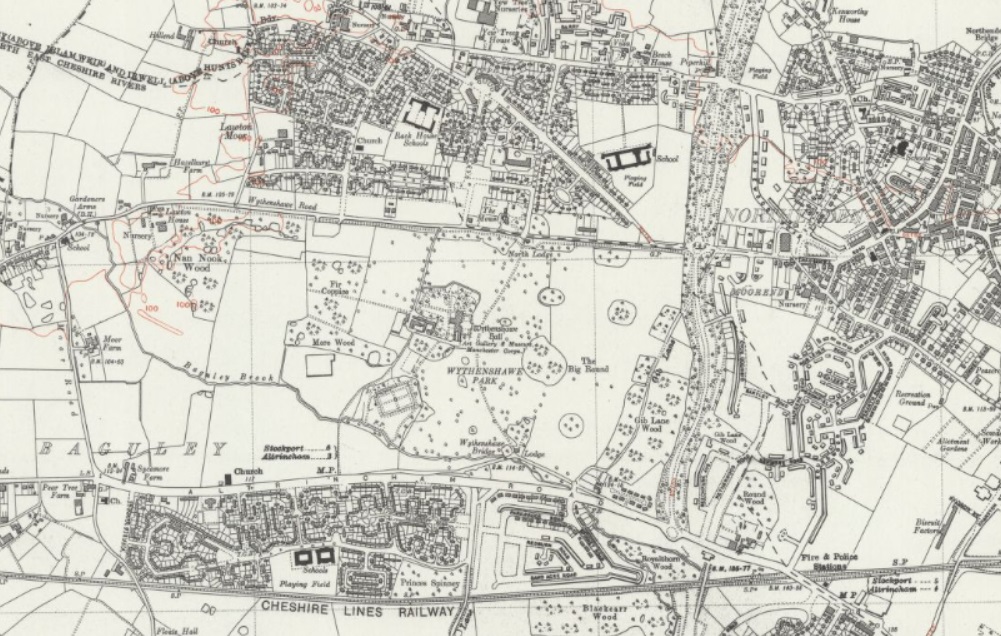Although now part of Greater Manchester (from Lancashire), Wythenshawe was for centuries in Cheshire, until Manchester Council so desired the estate, that they effectively made a compulsory purchase of it from the Cheshire councils in the 1920s to build what was once the largest council estate in Europe. It was also the site of Manchester’s first purpose built aerodrome, which served traffic between April 1929 and June 1930. As with many old buildings in Manchester, following a recent fire it is on the Heritage at Risk register.
Originally the site was a deer park. In 1540 Robert Tatton of Chester built the house as a family home. It may have originally have had a moat. The current building is a 16th century timber framed house and some alterations were made in the 1790s by Lewis Wyatt (1777-1853). Lewis was renowned for his country house work, he also was seen at Tatton Park, Heaton Park and Lyme Park, as well as Hampton Court and Kew Gardens. His plans for a new Houses of Parliament were rejected in 1836.
For nearly all of its existence as a family residence it descended down the Tatton line. The estate was owned by Thomas De Mascy in 1316. In 1370, Robert De Tatton of Kenworthy whose father had held lands in Northenden in 1297 married Alice, the heiress to the Wythenshawe Estates.
Around 1556, the Tatton family, through their loyalty to the Crown, also came to own Peel Hall which they used as a dower house.
William Tatton (1581-1616) drowned at the weir on the Mersey in 1616 whilst attempting to cross the river and his son Robert (1606-1669) (aged ten at the time) became a ward of Charles I. During the Civil War Robert naturally joined the Royalist cause with the result that his goods and chattels, totalling £1,649 7s 6d, were confiscated by Parliament.
Robert gave as good as he got, he was a thorn in the side of Colonel Duckinfield and the hall was beseiged for eigheen months by the Royalist Troops, with Robert and his loyal servants defending the property. It was not until two large pieces of ordnance were specially brought from Manchester that Robert surrendered. Tradition has it that a maidservant begged leave to fire at one of the Roundhead soldiers and killed him with one shot. Bullets from the siege have been found up to the 1940s by farmers ploughing their fields.

Robert became High Sherrif of Chester in 1645, and accompanied King Charles to Oxford where he surrendered in 1646. His estates were sequestered as a punishment, but after the Restoration they were given back to him. Charles II attaining the throne was partially down to the Cheshire rising in 1659 and William Tatton, Robert’s son took part in it being taken prisoner. William died in 1673 and his widow married Robert Radcliffe of Ordsall Hall, who was killed in a duel fought on Bowden Downs and is buried at Northenden Church.
In 1732 another William Tatton (1703-1776) succeeded to the estate and he married Hester (d 1780), the eldest daughter of John Egerton (1629-1724) of Tatton Park, and his son assumed by Royal License the name and arms of Egerton. His son William Tatton Egerton (1749-1806)¹ was followed by Wilbraham Egerton (1781-1856) and succeeded to the Tatton Park Estate. Wilbraham’s son William Tatton Egerton (1806-1883) became the 1st Baron Egerton.
William’s son, Thomas William Tatton (1783-1827) succeeded to the Wythenshawe estate. He married Emma Grey (1782-1851) in 1807, the daughter of John Grey of Stamford Hall in Northumberland. Thomas and Emma had eleven children, ten girls and one boy. It was Thomas William Tatton (1816-1885) who inherited the estate.
Thomas married Harriet Susan Parker in 1843 in Walton Le Dale. He became a magistrate for Cheshire and treasurer of Henshaws Blind asylum. He was a conservative, and acted as chair for the local party, holding regular picnics at Wythenshawe for Conservative Societys in the area, including one in 1871 for the Ardwick Conservative Club. He died aged 68 shortly before 7pm on 10 May 1885 as a result of inflammation of the lungs.
He was succeeded by Thomas Egerton Tatton who was the last family member to end his days at the hall. Thomas married Essex Mary Cholmondeley (1855-1942), the granddaughter of Thomas Cholmondeley the first Baron Delamere and a descendant of Robert Walpole. Thomas was appointed a JP in 1868 and became a councillor for Timperley on the formation of Cheshire County Council which he continued to do until his health began to fail in 1907. He was a great lover of Wythenshawe and in his final years rarely strayed from it. He was vice president of the Stockport Savings Bank and for many years resisted the pressure from Manchester Council for a sale so they could pursue their plans for a housing scheme.
His son Robert Henry Grenville Tatton (1883-1962) succeeded to the estate, and in 1926 he bowed to the inevitable and sold 2,500 acres of land Manchester Corporation for their plans. Wythenshawe Hall and 250 acres of land were sold to Ernest Simon² (1879-1960).
Robert and his wife, Maud Hamilton moved to Wynbunbury in Cheshire. With him the male line died out, his son William Grey Maurice Tatton (1912-1926) died whilst attending Eton School and William’s younger brother, Christopher was killed on the HMS Prince of Wales in the South China Sea when the boat sank after a Japanese air attack on 10 November 1941, just three days after Pearl Harbor.
Ernest Simon gave the park to the People and City of Manchester for ever to be kept as an open space. The rest of the land was Manchester’s to build on and build they did. The vision was for a garden city. The councillors had originally had their eye on the Hall to be demolished to be part of that build.
One day after a routine³ councillor visit to Abergele Sanatorium Alderman William Turner Jackson and some of his now refreshed colleagues were returning to Manchester. He told the driver to make a detour and they stopped outside the richly cultivated farmlands beside Wythenshawe Hall and he turned to them and said These farmlands, gentlemen, are where the slum dwellers of Manchester will one day live. He had an ally on the council. One Ernest Simon, who had been appointed Chairman of the first Municipal Housing Committee.
The main motivation behind the purchase was that land could be bought for £80 per acre, against £400 per acre in the city. Garden cities and lack of pollution did not have that much to do with it.
The designer of Wythenshawe was to be Barry Parker, who had built Letchworth Garden City. Plans were drawn up to build housing for 100,000 people.
Another snag was that Bucklow council would be providing the essential services. The upshot would therefore be that Manchester would lose its ratepayer base (and voters) , having built subsidised housing leaving the rest of the population to suffer increased rates
It took two attempts to get a bill through Parliament to succeed. In 1927 a bill seeking powers to incorporate Northenden, Bagueley and Northern Etchells into the City was thrown out, following pressure from Cheshire County Council. it was not until 1930 that the Manchester Corporation Extension Act authorised the annexation of the land and the Government sanctioned the first 10,000 houses. To put things in perspective, Wythenshawe, at 5,657 acres, is 365 acres larger than Salford.
The next problem to be overcome was that tenants, although offered cheaper rents, were not happy with the increased travel costs, and demanded concessionary fares. Grandiose plans for lidos and libraries were continually shelved because of rising costs. Although there were houses and light industry springing up, the town was a social wilderness. Only a couple of hotels had appeared and no cinema or theatre had been built.
In 1934 the largest mass removal was carried out. The slum dwellers of Hulme were uprooted and sent to Wythenshawe. Trouble ensued. The Medical Officer of Health ordered that because they lived in such filthy hovels, that their clothing should be fumigated, causing angry scenes. The Hulme residents did not want to go, whereas those in outlying areas who had not been offered a chance did.
For the exiles from Hulme, Wythenshawe did not have the cosy street life of the town centre. There were no pubs on the corner and many trekked back home to find their old houses boarded up. Manchester Council did not twig that building amenities such as cinemas and pubs would make the area more attractive. The onset of war delayed this even further.
Meanwhile back at The Hall, deathwatch beetle was discovered in 1946 and a reluctant council had to sanction restoration works totalling £20,000. Cries went up from councillors to throw in the towel, demolish the Hall and build a modern pavillion.
Fortunately that did not happen. Wythenshawe survives, despite a recent damaging fire. It has an active friends group and it is a much loved tourist attraction for locals. I remember several happy trips there as a young boy, playing in the paddling pool.
Thank goodness it survived.
Let’s see some pictures:

Manchester Times 3 March 1893 
Manchester Evening News 13 February 1964 




© Manchester Image Library 
© Manchester Image Library 
© Manchester Image Library

¹ Always keen to point out a Heatons source, William Tatton Egerton died in Heaton Norris in April 1806, and was buried at St Thomas there.
² Also famous for introducing white flour to England and one time Chairman of the BBC Board of Governers, aka Baron Simon of Wythenshawe.
³ They do have it hard, don’t they?
© Allan Russell 2021.


3 thoughts on “100 Halls Around Manchester Part 46: Wythenshawe Hall, Wythenshawe.”